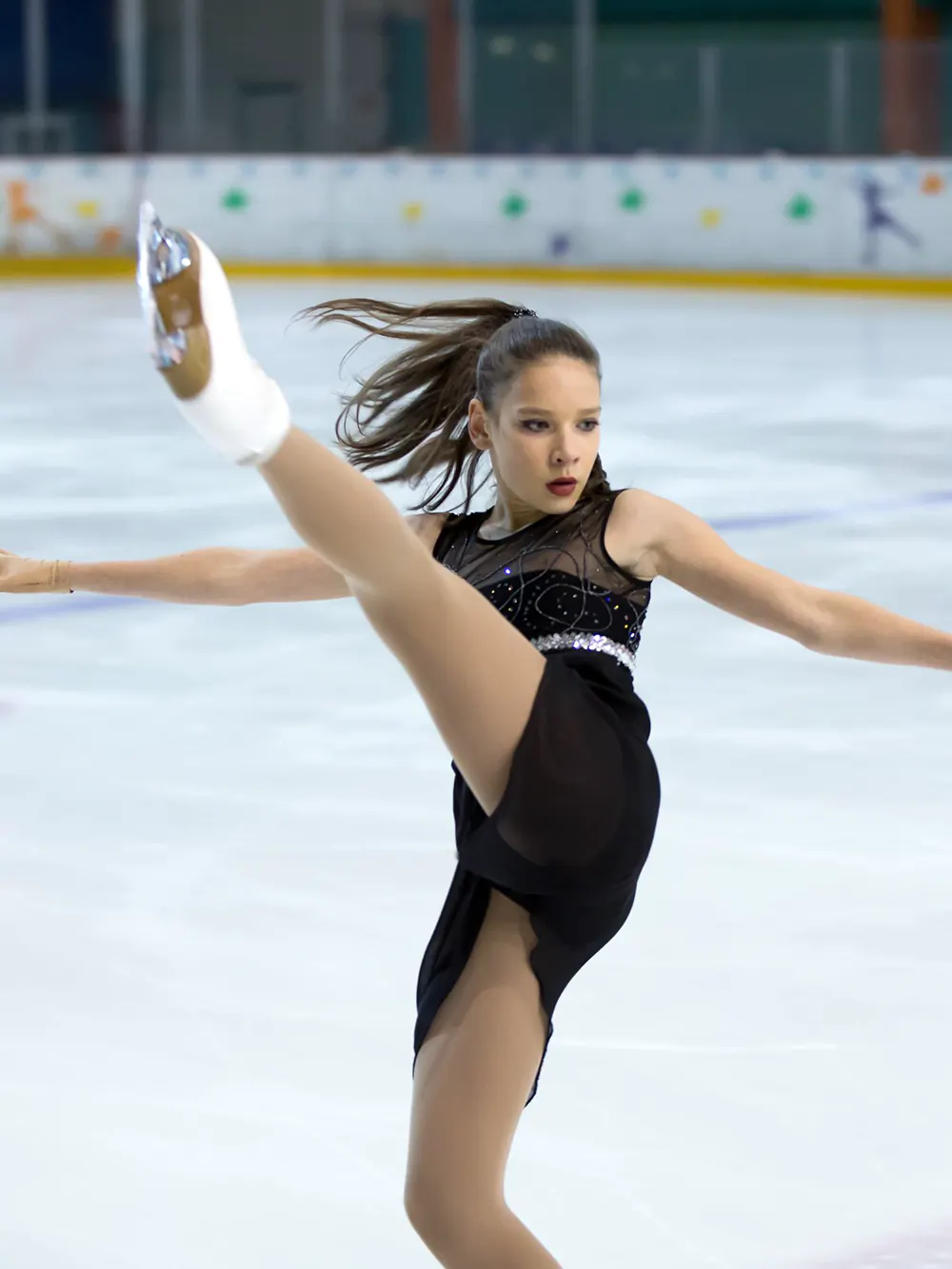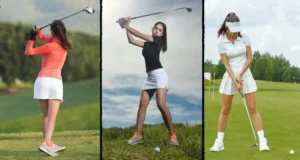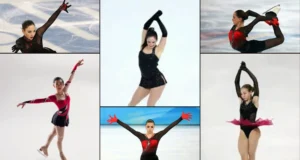Over the booty shorts and double tights, there are figure skating secrets few get to see. Under the sparkly dresses, bedazzled pants, and dazzling costumes, figure skaters endure rigorous routines that require kink-free maneuvering and invisible support. To achieve the weighted grace and effortless elegance you see on the ice.
Figure skaters layer up in dance belts, tights, leotards, and slips made from the finest spandex and Lycra. From wiggly leaps to dizzying spins, they rely on meticulously chosen undergarments to keep everything where it should be. So drop the curtains on those sultry costumes, and let’s peek behind the scenes at what figure skaters wear underneath all that ice magic.
What do figure skaters wear under their dresses?
Figure skaters wear special undergarments under their costumes to provide support, comfort, and function while skating. Some common items they may wear include
Leotard or unitard
Figure skaters wear a tight-fitting one-piece called a leotard or unitard under their dresses. This garment covers the torso and legs, providing stability and smoothing lines for the costume. It is considered essential for most skaters.
The leotard or unitard helps the skater maintain a streamlined appearance on the ice. It hugs the body tightly, creating a sleek and polished look while performing jumps, spins, and intricate footwork. Covering the entire torso and legs ensures no visible lines or distractions could take away from the overall presentation.
The tight fit of the leotard or unitard also offers stability to the skater. It helps keep the dress in place, preventing it from shifting or riding up during intense movements. This is particularly important for skaters who execute complex jumps, lifts, or other acrobatic elements that require precise body positioning.
In summary, the leotard or unitard is a foundational undergarment for figure skaters. Its tight fit provides stability, smoothes lines, and helps maintain a polished appearance during performances on the ice.

Tights or leggings
Figure skaters wear tights or leggings under their dresses for several important purposes. These often come in opaque black and are made of spandex or Lycra material. Both female and male skaters wear them.
One key reason for wearing tights is to prevent chafing. The smooth, stretchy fabric of tights helps to reduce friction between the skin and the dress, minimizing the risk of discomfort or irritation during movements on the ice. This is especially important as skaters execute various spins, jumps, and intricate footwork that involves repetitive motions.
Another purpose of tights is to cover exposed skin. Skaters’ dresses often feature cutouts or sheer sections that add visual appeal to their costumes. By wearing tights, skaters ensure that any skin that would otherwise be visible remains covered, creating a polished and unified appearance.
Moreover, tights also help keep the dress in place. The clingy nature of spandex or Lycra helps to hold the dress securely against the body, preventing it from shifting or riding up during dynamic and physically demanding elements. This allows skaters to maintain a neat and professional presentation throughout their performances.
In summary, tights or leggings made of spandex or Lycra are worn by figure skaters to prevent chafing, cover exposed skin, and keep the costume in place. They offer comfort, protection, and a streamlined look for both male and female skaters on the ice.
Slip
Figure skaters often wear a slip under their dresses, which serves an important purpose. A slip is a loose-fitting and lightweight garment that provides a smooth surface for the outer layers of the dress to glide over. This is done to avoid catching or snagging on the ice during spins, jumps, and intricate footwork.
The slip acts as a protective barrier between the dress and the skater’s body. It helps to reduce friction and allows the dress to move freely without getting entangled or hindered by the movements on the ice. By creating a smooth surface, the slip ensures that the dress flows gracefully and maintains its intended shape and design.
Moreover, the slip also adds an extra layer of coverage. Skaters’ dresses often have delicate or intricate details that can be vulnerable to damage if exposed directly to the ice. The slip helps to shield the dress from potential contact with the ice surface, minimizing the risk of tearing or snagging.
In summary, the slip is a lightweight, loose-fitting garment worn under a figure skater’s dress. It provides a smooth surface for the dress to glide over, preventing catching or snagging on the ice. Additionally, the slip offers a layer of protection for the dress, preserving its integrity during performances.
Sports bra
Figure skaters frequently wear sports bras under their dresses, and they serve an important purpose. A supportive sports bra helps secure the bust area and minimizes movement while performing challenging routines on the ice.
During jumps, spins, and other dynamic movements, the body exerts significance, which can lead to breast movement. A sports bra provides the necessary support to minimize bouncing or discomfort, allowing skaters to focus on their performance without distractions.
Sports bras worn by figure skaters typically do not have underwires, as they could cause discomfort or restrict movement. Instead, they are designed with supportive fabrics and construction techniques to provide stability and control. They offer a snug and secure fit to keep the bust area in place, reducing excessive movement that could hinder performance or cause discomfort.
By wearing a sports bra, skaters can maintain a comfortable and stable bust area, ensuring they have the freedom and confidence to execute their routines precisely and gracefully.
In summary, a sports bra is a supportive undergarment that figures skaters wear to secure the bust area and minimize movement during challenging routines. It offers comfort, stability, and confidence, allowing skaters to focus on their performance without distractions.
Bodysuit
Figure skaters often wear a bodysuit under their dresses, and it serves a specific purpose. A bodysuit is a skin-colored one-piece garment that acts as a second layer under the costume. It provides invisible coverage and helps smooth lines, making the costume appear seamless.
The bodysuit creates a unified and polished look by covering the entire torso. It serves as a base layer, ensuring no visible undergarments or skin-tone inconsistencies could distract from the overall presentation. The bodysuit helps maintain a professional and cohesive aesthetic by providing complete coverage.
Furthermore, the bodysuit helps in smoothing lines. It is snug fit and seamless construction creates a smooth surface for the outer layer of the costume to lay over. This minimizes the appearance of any wrinkles, bumps, or uneven contours that may be present on the skater’s body, enhancing the visual appeal of the costume.
In summary, a bodysuit is a skin-colored one-piece garment worn by figure skaters under their dresses. It acts as a second layer, providing invisible coverage and smoothing lines to create a seamless look. The bodysuit contributes to a polished and unified presentation on the ice.
Compression shorts
Some figure skaters wear compression shorts under their tights or leotards, and there are specific reasons behind this choice. Compression shorts are spandex shorts that provide added support, comfort, and moisture-wicking properties.
The primary reason for wearing compression shorts is to offer additional support. These shorts snugly fit the body and provide gentle compression, which can help stabilize the muscles during intense movements on the ice. This added support can contribute to a sense of security and help reduce muscle fatigue or strain.
Comfort is another benefit of wearing compression shorts. The smooth and stretchy spandex material allows for a full range of motion without restriction. Skaters can move freely and comfortably, focusing on their performance without the distraction of discomfort or chafing.
Moreover, compression shorts often have moisture-wicking properties. Skating is a physically demanding activity that can cause the body to sweat. The moisture-wicking feature of the shorts helps draw moisture away from the skin, keeping the skater feeling drier and more comfortable throughout their routine.
In summary, compression shorts are spandex shorts worn by some figure skaters under their tights or leotard. They provide added support, comfort, and moisture-wicking benefits. These shorts contribute to a sense of stability, freedom of movement, and dryness while performing on the ice.

Summary
A support, function, and comfort wardrobe is underneath the dazzling and glamorous figure skating outfits. Skaters rely on a range of specialized undergarments to produce seamless elegance on the ice.
Tight leotards or unitards provide essential anchoring and stability, smoothing lines for the costumes. Opaque tights made of spandex or Lycra prevent chafing, cover skin and keep costumes from shifting. Slips and bodysuits create a barrier between costumes and undergarments, allowing smooth gliding over the ice.
Sports bras and bralettes secure skaters’ chests during intricate choreographies for bust support. Compression shorts add lumbar support and wick away moisture. Dance belts for men provide shaping and comfort.
All these undergarments share key features: they are lightweight, breathable, and stretchy, made from fabrics like spandex and Lycra. Their tight, form-fitting nature helps skaters achieve core stability and control while executing powerful moves.
Ultimately, the undergarments are invisible to spectators but essential for skaters to transform costumes into performance art on ice. Blurring the lines between costume and body allows skaters to bring characters to life through movement and expression instead of the flashy dress alone.
The magic of figure skating lies not in the dazzle of the dresses but in the grace, skill, and athleticism that skaters cultivate with layers of support beneath.
FAQ
What type of tights do figure skaters wear under their dresses?
Figure skaters wear various types of tights under their dresses, such as footed, footless, stirrup, and over-the-boot tights. These tights are thicker and warmer than regular tights. They help keep the skaters’ muscles warm and shield their skin from potential cuts caused by the skate blades. Some skaters add a thin layer of padding over their tights for extra protection during falls. Whether skaters wear tights under or over their boots is a personal aesthetic preference.
Do figure skaters wear any additional protective gear under their dresses?
Figure skaters sometimes wear padding over their tights for fall protection, but no other specific protective gear is under their dresses.
Why do figure skaters not wear pants?
Traditionally, figure skaters wear dresses instead of pants for their competitions to maintain an elegant and flowy appearance. This tradition may have been influenced by rules that required female skaters to wear skirts or dresses in the past. However, recent rule changes have allowed skaters to wear pants if they prefer. Despite this, many skaters still wear dresses as they align with their performance aesthetic. While some skaters opt for pantsuits or unitards, wearing dresses remains more common in competition attire.



